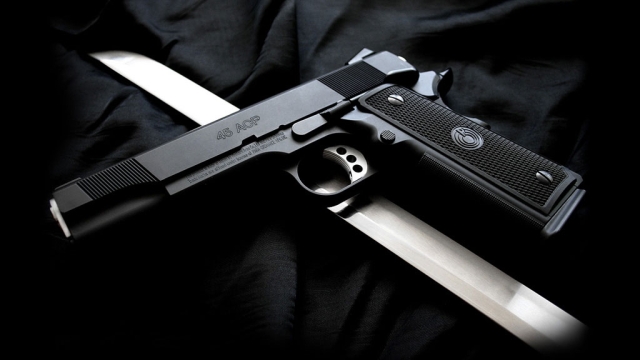Firearms, a topic that elicits a range of emotions and opinions among individuals, has been a subject of fascination, controversy, and exploration for centuries. As one’s knowledge and understanding of firearms deepens, a myriad of elements comes into play, from the intricacies of ammunition to the diverse array of weaponry available today. Join us as we embark on a journey through the captivating world of firearms, where we uncover the power concealed within their barrels and delve into the various aspects that make these weapons both awe-inspiring and contentious. So, let us embark on this enlightening exploration, as we unravel the mysteries of firearms and open our minds to the multifaceted nature of this complex subject matter.
Understanding Different Types of Ammunition
In the world of firearms, ammunition plays a crucial role as it directly influences the performance and capabilities of a firearm. Understanding the different types of ammunition available is essential for any firearm enthusiast or those interested in learning about firearms.
First, we have the most commonly used type of ammunition, known as centerfire ammunition. This type of ammunition features a centrally located primer that ignites the gunpowder upon impact, thereby propelling the projectile forward. Centerfire ammunition is widely used in handguns, rifles, and shotguns, offering a reliable and versatile option for various applications.
Next, we have shotgun shells, which are often used in shotguns for hunting, sport shooting, and self-defense. Unlike centerfire ammunition, shotgun shells contain multiple projectiles, or shot, which spread out upon firing. The size of the shot pellets varies, allowing shooters to choose the appropriate shell for different targets, such as small game or larger birds.
Moving on, rimfire ammunition is another type commonly used, especially in smaller caliber handguns and rifles. In contrast to centerfire ammunition, rimfire cartridges have the primer located within the rim of the cartridge itself. This design makes rimfire ammunition less powerful than centerfire ammunition, typically used for activities such as plinking or small game hunting.
By understanding these different types of ammunition, one can make informed decisions regarding the firearm and ammunition combination suitable for their needs. It is imperative to emphasize the importance of responsible firearm usage and adherence to local laws and regulations when engaging in any firearm-related activities.
Exploring the Functioning Mechanisms of Firearms
In this section, we will delve into the intricate workings of firearms. Understanding the functioning mechanisms is crucial in comprehending how these weapons operate.
-
Action Types
Firearms employ various action types to discharge ammunition. These types can be classified into several categories, such as bolt action, semi-automatic, and fully automatic. Bolt action firearms require manual cycling of the bolt to load and unload the ammunition. Semi-automatic firearms automatically load a fresh round after each shot, while fully automatic firearms can continuously fire rounds as long as the trigger is held.
-
Ignition Systems
The ignition system plays a pivotal role in initiating the firing sequence of a firearm. One prevalent system is called the "percussion system," where a small explosive charge ignites and sets off the propellant in the cartridge, propelling the bullet out of the barrel. Another commonly used system is the "rimfire ignition system," where the primer compound is applied to the rim of the cartridge case instead of the center.
-
Operating Principles
Firearms can be designed based on different operating principles. The two main principles are recoil-operated and gas-operated systems. In a recoil-operated firearm, the energy produced by the fired round ejects the spent casing and loads a fresh cartridge. On the other hand, gas-operated firearms use gas pressure from the fired round to cycle the action, allowing for automatic or semi-automatic firing.
By exploring these functioning mechanisms, we gain a deeper understanding of how firearms work and the various elements that contribute to their operation.
Examining the Impact and Controversies Surrounding Firearms
The impact of firearms on society is undeniable. They have become a central part of numerous discussions surrounding safety, self-defense, and crime prevention. However, their existence also stirs up controversies and raises serious concerns.
One aspect to consider is the potential consequences of the accessibility and widespread use of firearms. While they can provide a means of protection for individuals, there is an inherent risk associated with their misuse or falling into the wrong hands. Incidents of accidental shootings and suicides are tragic reminders of the need for responsible ownership and usage of firearms.
The debate on gun control is another contentious issue surrounding firearms. Advocates argue for stricter regulations to minimize the chances of firearms being involved in criminal activities, while opponents argue for the preservation of the Second Amendment rights and the importance of self-defense. This divide often sparks heated debates and has become a deeply divisive political topic.
Furthermore, firearms are often connected to high-profile acts of violence, such as mass shootings. The devastating consequences of these events prompt discussions on mental health, sociopolitical influences, and the efficacy of current gun laws. Finding a balance between protecting public safety and preserving individual rights remains an ongoing challenge.
In Conclusion, firearms possess a significant impact on society, eliciting both positive and negative outcomes. While they can provide protection and a sense of security, they also carry inherent risks and contribute to debates on gun control. To fully understand the complexities surrounding firearms, it is necessary to engage in open and empathetic discussions that consider different perspectives and strive for mutually beneficial solutions.

